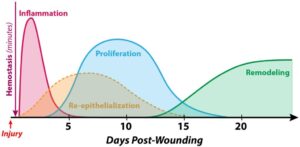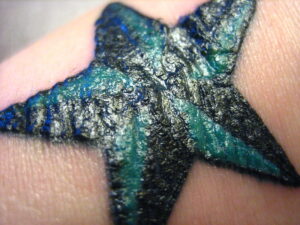Hot Tubs/Pools and Tattoos
![]() December 6, 2022
December 6, 2022

When you get a tattoo, it is important that you do not expose the tattoo to too much water, at least not while the tattoo is healing.
If you do, you run the risk of infection. It may even slow down the speed at which the tattoo heals. So, when is it safe to soak in a hot tub after getting a tattoo?
It is recommended that you avoid soaking in a hot tub for at least 2 weeks after getting a tattoo. However, for larger tattoos, the waiting period may be a little longer. Your tattoo artist will be able to provide you with more information.
Let’s go into depth on why there is a waiting period. We also want to talk a little bit about when you know that you can actually climb into a hot tub after receiving a tattoo.
Chlorine, Hot Tubs, and Healing a Tattoo
Making a mark and introducing things into your skin starts a cascade effect on your body’s immune system. Specialized cells do their part by locking onto the foreign particles, identifying them as something disrupting their homeostatic state, and working to repair the damage and possible infectious load that is introduced. Adding to the stress experienced by a client’s naturally occurring healing process, the effects of chlorine as an irritant become more evident. Its role as a killer of unwanted pathogens is well documented, but chlorine’s role as an irritant is more critical.
The role of your Skins Microbiome

Living on your skin are colonies of bacteria. They are a world of their own and in constant flux. Some are good for you (by keeping the bad ones in check). Others are bad for your health if they end up getting past your body’s defensive layer (your skin).
A disrupted microbiome occurs when receiving a tattoo. The breaks in the skin give opportunistic pathogens a chance to infect a person. The breaks in the skin make it possible for these pathogens to take hold where they would otherwise not be able to. This disruption to the layer of skin, the main organ that protects against outside infection, occurs when a tattoo artist implants pigment into the dermis of a client’s skin. The body must work to restore homeostasis and heal the break in the skin that occurs after being tattooed.
“Homeostasis is when everything is a state of equilibrium between the stuff in/on your body.”
The healing process is not atypical and follows a well-described path unless a person suffers from some underlying medical condition.
If there are any visible scabs on the tattoo, it is not fully healed.

So, rule #1– Once all of the scabs have fallen off; you are safe to go into a hot tub or go swimming. Take this at face value, though, because if you have been picking your scabs, creating newly opened areas of the skin that are prone to infection, getting in the water is a bad idea. This is usually why most aftercare regimes have the addendum of *don’t pick or scratch your tattoo*.
Bacteria, Protozoa, Fungi, Viruses, and Hot Tubs
Regardless of how uncomfortable the water can be in a hot tub for a person, warm water is a perfect breeding ground for pathogens. The water temp of a hot tub can accelerate the growth of some pathogens! Some of the organisms found in the hot tub water are not a big worry to most humans with a new tattoo, but others can be hazardous. Here is a breakdown of what we could find lurking in hot tubs, including E. coli, shigella (which causes dysentery), campylobacter, and salmonella.
- Bacteria are generally killed quickly by chlorine disinfectant inadequately maintained swimming pools at a concentration of 1 part per million. Still, in most cases, the evaporation or neutralization of chlorine starts as soon as supporting levels are achieved (this is why pool maintenance is an ongoing process, regardless of use).
- Protozoa, such as cryptosporidium is complicated to get rid of in pools, even with proper maintenance. Both the parasite and the disease are commonly known as “Crypto,” and many varieties of Crypto infect animals, some of which also infect humans. The parasite is protected by an outer shell that allows it to survive outside the body for long periods and makes it very tolerant to chlorine disinfection.
- Giardia is a protozoan that causes diarrhea. This germ is found in the fecal matter of a person or animal who has been infected. It has a tough outer shell that allows it to survive for up to 45 minutes, even in properly chlorinated pools.
Some of these pathogens are highly resistant to chlorine and can survive in typical chlorine concentrations for days. This is why people are told NEVER to ingest pool water!
How Do I Know If My Tattoo Is Fully Healed?
Technically a tattoo isn’t considered fully healed until the new layer of skin has grown over it, which takes about three months. It pays to be mindful of the area and monitor it for signs of infection, including pain, swelling, discharge or fever. If you think your tattoo has become infected, seek medical advice immediately.
If you’re able to stay out of water for the full three months, that’s healthier. Most people aren’t willing to interrupt their fun for that long, though, and four weeks should be enough time.

